The Future of Hybrid Work: How to Manage Global Teams
While hybrid and remote work promise flexibility and access to global talent, they also introduce new challenges for the future of hybrid work, including managing scattered teams, ensuring fair pay across countries, and keeping everyone aligned.
Without the right systems in place, businesses risk chaos: payroll errors that frustrate employees, miscommunication that slows projects, and cultural gaps that hurt collaboration.
Read on to learn more about the key strategies to make hybrid work efficient, employee-friendly, and compliant.
What are the types of hybrid work models?
There are several hybrid work models companies use to balance flexibility and collaboration. Here’s a look at the main ones.
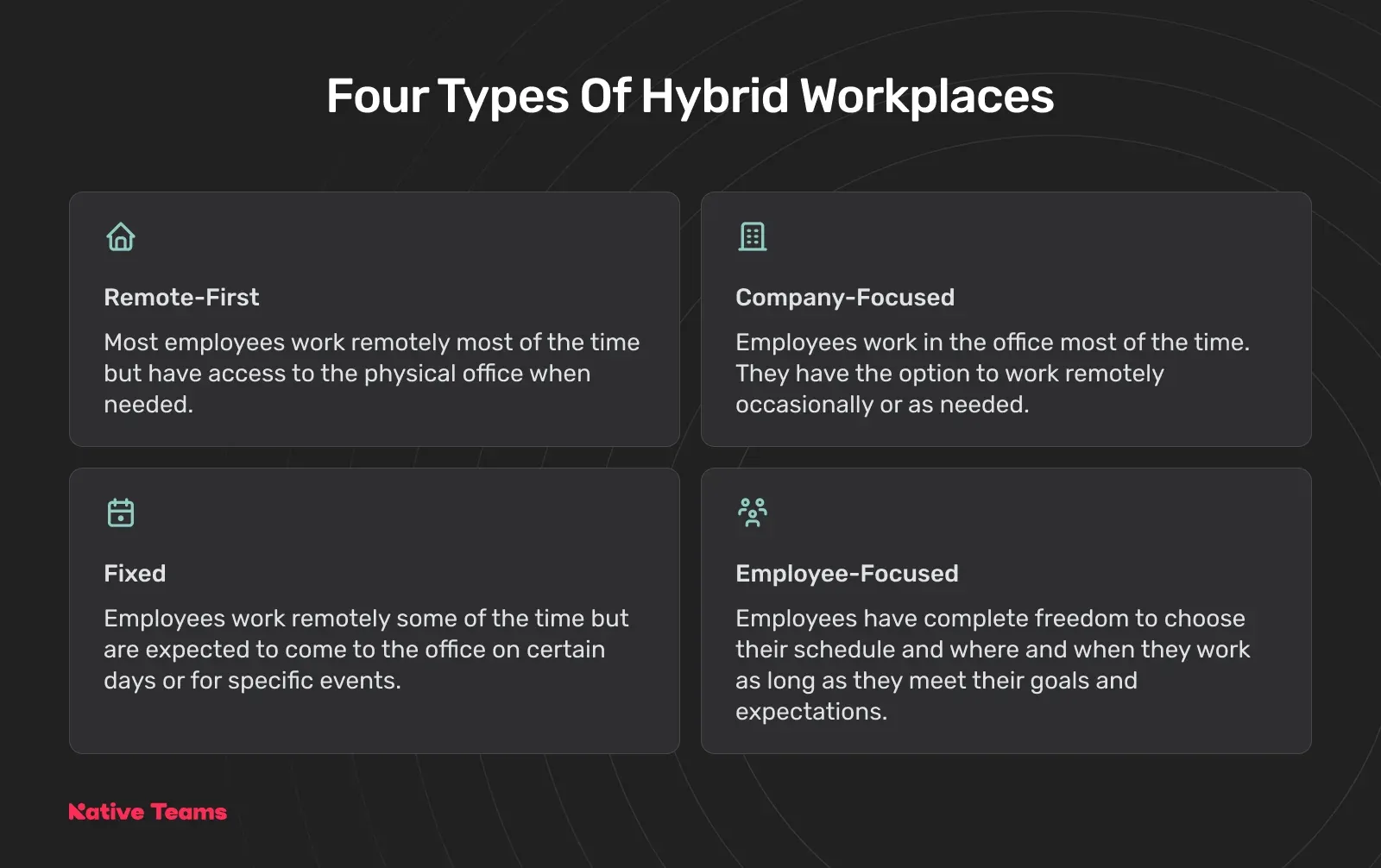
1. Office-first model: The office is the main workplace, but employees can work remotely a few days per week.
It helps maintain collaboration but can feel restrictive for those who prefer full flexibility.
2. Remote-first model: remote work is the norm, and offices are just for optional meet-ups or collaboration.
It’s ideal for global teams and reduces office costs, but it requires strong digital communication to prevent isolation.
3. Flexible (employee choice) model: Employees have full freedom to choose their work location on any given day.
While this autonomy boosts satisfaction, it can make coordination tricky without proper scheduling tools.
4. Split-week model: Everyone follows the same schedule for remote and office days. Although this creates structure, it may feel rigid and still requires office space.
5. Week-by-week model: Teams alternate between full remote and full office weeks.
It allows deep focus during remote weeks but can be disruptive to routines and requires careful planning.
6. Role-based model: Office attendance depends on job function. For example, customer-facing roles might need more office presence, while developers can work remotely. The downside is a potential sense of unfairness.
7. Project-based model: Employees work remotely most of the time and only come to the office for specific projects, events, or sprints. It’s highly flexible and cost-effective, but requires strong planning to maintain cohesion.
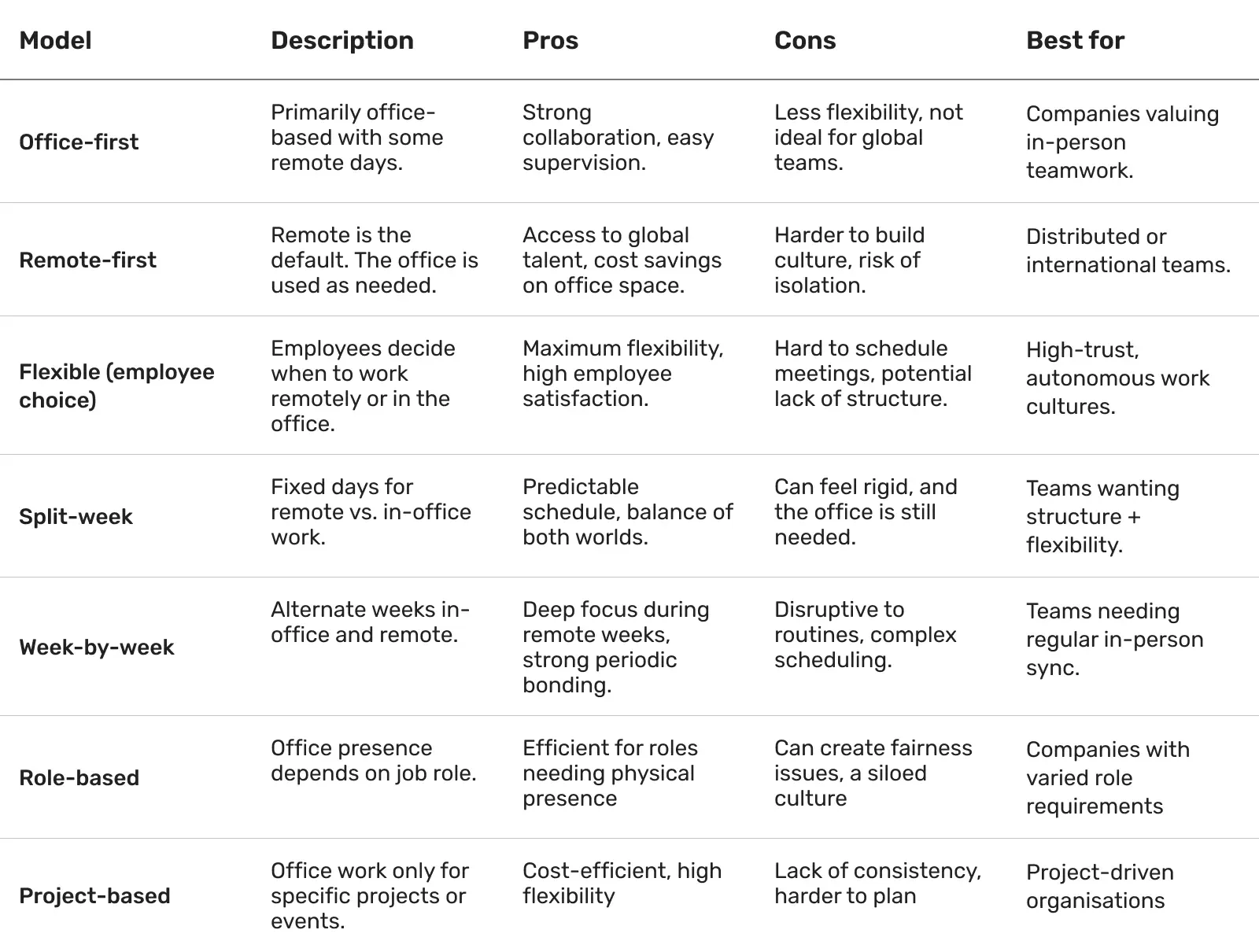
How to manage global teams efficiently: Challenges and solutions
Managing a global hybrid workforce is like playing chess on multiple boards at once: time zones, cultures, compliance, and engagement all demand careful moves to avoid costly missteps.
Challenge 1: Time zones
A Microsoft study surveying 31,000 professionals across 31 countries found meetings after 8 p.m. increased by 16% year-over-year, with nearly 20% working weekends, and over 5% logging in on Sunday evenings.
These off-hour demands fuel burnout and negatively impact employees, making real-time collaboration more challenging.
💡How to solve this challenge?
To counter time-zone chaos, lean into platforms that support asynchronous workflows, such as Slack, Teams, and Trello, and promote smart tool use as a cultural norm.
You can also use AI-driven scheduling applications to manage meetings across time zones efficiently, reducing fatigue.
Here are some suggestions:
- Reclaim AI: Automatically identifies optimal meeting times for recurring meetings across global team members by factoring in schedules, time zones, and personal work preferences.
- Clockwise: Automatically reshuffles meetings and applies smart prioritisation.
- Motion: Combines task scheduling with project management and meetings in one platform.
- Akiflow: Provides dual time zone displays and intuitive scheduling features.
Challenge 2: Cultural differences
When teams span multiple countries, differing work cultures and communication styles can clash.
Without deliberate efforts to bridge these gaps, trust can decline, decisions can stall, and misunderstandings can multiply.
💡 How to solve this challenge?
Managing across cultures requires mindfulness of communication styles, work expectations, and holidays:
- Promote cross-cultural training for leaders and teams. For example, U.S. managers are trained to soften direct feedback when working with Japanese teams to respect cultural harmony.
- Encourage team rituals that celebrate cultural diversity, which enhances belonging. You can introduce monthly cultural spotlight sessions during hybrid team meetings where members share traditions, holidays, food, or music from their countries. During Diwali, team members from India host a virtual celebration, sharing stories and festive recipes. In December, others showcase Christmas or Hanukkah traditions. These activities can also help reduce feelings of isolation in remote teams, which is why remote work isolation tips often emphasize cultural connection.
- Solicit and act on feedback to continuously improve inclusion and collaboration practices. Consider conducting quarterly anonymous surveys and virtual focus groups to gather employees' feedback on cultural barriers, communication challenges, and inclusivity. Then, based on feedback, you can update collaboration guidelines to be more culturally sensitive.
Challenge 3: Compliance and legal issues
As teams cross borders, payroll, labour laws, and tax regulations quickly become a complex ordeal.
What’s perfectly legal in one country may be restricted, taxed differently, or completely prohibited in another, creating a set of rules that can overwhelm even experienced HR teams.
What’s worse, missteps aren’t just administrative but can lead to fines, reputational damage, or employee dissatisfaction.
💡 How to solve this challenge?
EORs or global payroll platforms are popular for a good reason.
They simplify the process and handle all tax and payroll complexities to ensure you stay compliant, regardless of your business location.
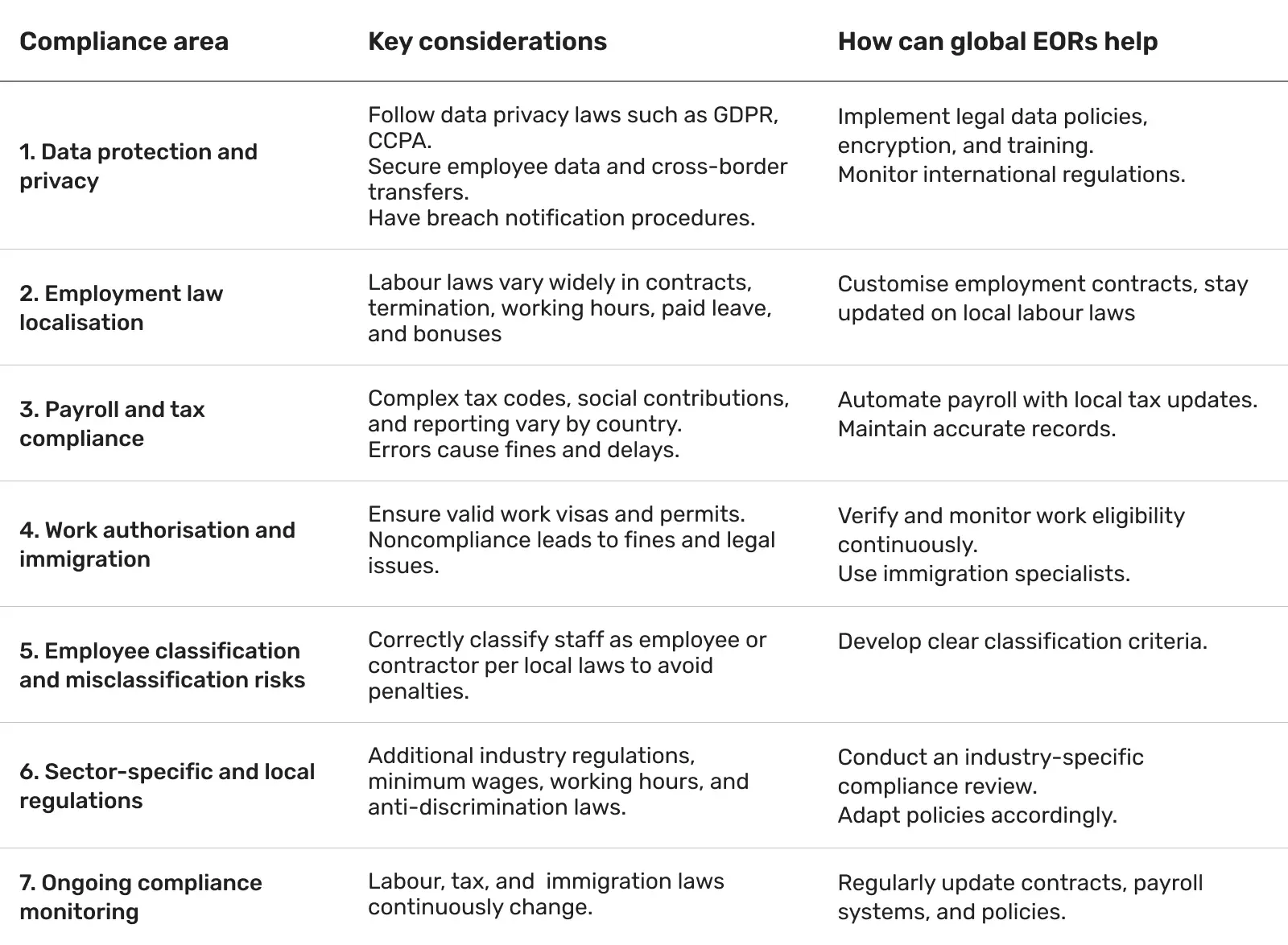
With Native Teams, an EOR and PEO provider with legal entities in more than 85 countries, you can ensure local compliance with:
- Country-specific compliant employment contracts tailored to local labour laws,
- Payroll management in employees’ preferred currencies, and
- Handling all tax obligations and regulatory filings.
We act as the legal employer, protecting you from penalties related to employee misclassification and continuously monitor changing employment laws to maintain compliance.
How to manage global teams recap: A quick checklist
Maintaining the efficiency of a global team requires a strategic approach and a clear structure.
Our checklist will help you ensure nothing falls through the cracks, no matter where your employees are located.
✅ Establish a clear communication protocol.
✅ Use shared platforms for project updates and knowledge management to avoid silos.
✅ Conduct regular one-on-ones to understand individual needs, challenges, and motivations.
✅ Empower local team leads or champions who understand regional nuances to drive hybrid practices on the ground.
✅ Set clear goals and accountability metrics that focus on outputs rather than hours worked.
✅ Use cloud-based project management platforms for task tracking and transparency.
✅ Customise hybrid schedules and policies by team function, country labour laws, and employee preferences.
✅ Use data and regular feedback to assess performance based on deliverables, not presence.
✅ Provide remote learning and development opportunities accessible globally.
✅ Recognise and reward contributions consistently regardless of location.
How to design a payroll strategy for hybrid teams?
Global payroll management remains complex due to currency conversion, compliance, and payment method preferences.
1. Complexities in currency conversion and payment methods
- Employees and contractors may prefer to be paid in their local currency or a global currency, which requires multi-currency payroll systems.
- Currency fluctuations and conversion fees can affect salary costs and net pay.
- Payment methods vary widely, including direct bank transfers, digital wallets, and even cryptocurrencies, demanding flexible payment platforms.
2. Diverse compliance requirements
- Each country has different mandates on tax withholdings, social security contributions, mandatory benefits, and reporting obligations.
- Hybrid teams working remotely face risks in payroll compliance if they are improperly classified or if payroll processing doesn’t accurately reflect local regulations.
- Data privacy laws, such as the GDPR and CCPA, require the secure handling of payroll data to prevent breaches and fines.
3. Multi-jurisdictional tax and social contribution management
- Employers must ensure that taxes and social contributions are calculated and paid accurately in accordance with each country’s regulations.
- Keeping up with constantly changing laws is key since mistakes can lead to fines.
4. Payroll and HR system integration challenges
- Often, payroll data is siloed in separate systems that don't integrate well with HR and finance platforms.
- Lack of integration leads to errors, difficulty consolidating payroll costs, and inefficiencies in reporting and compliance management.
How to address these challenges to streamline global payroll?
Here are handy strategies to manage global payroll efficiently.
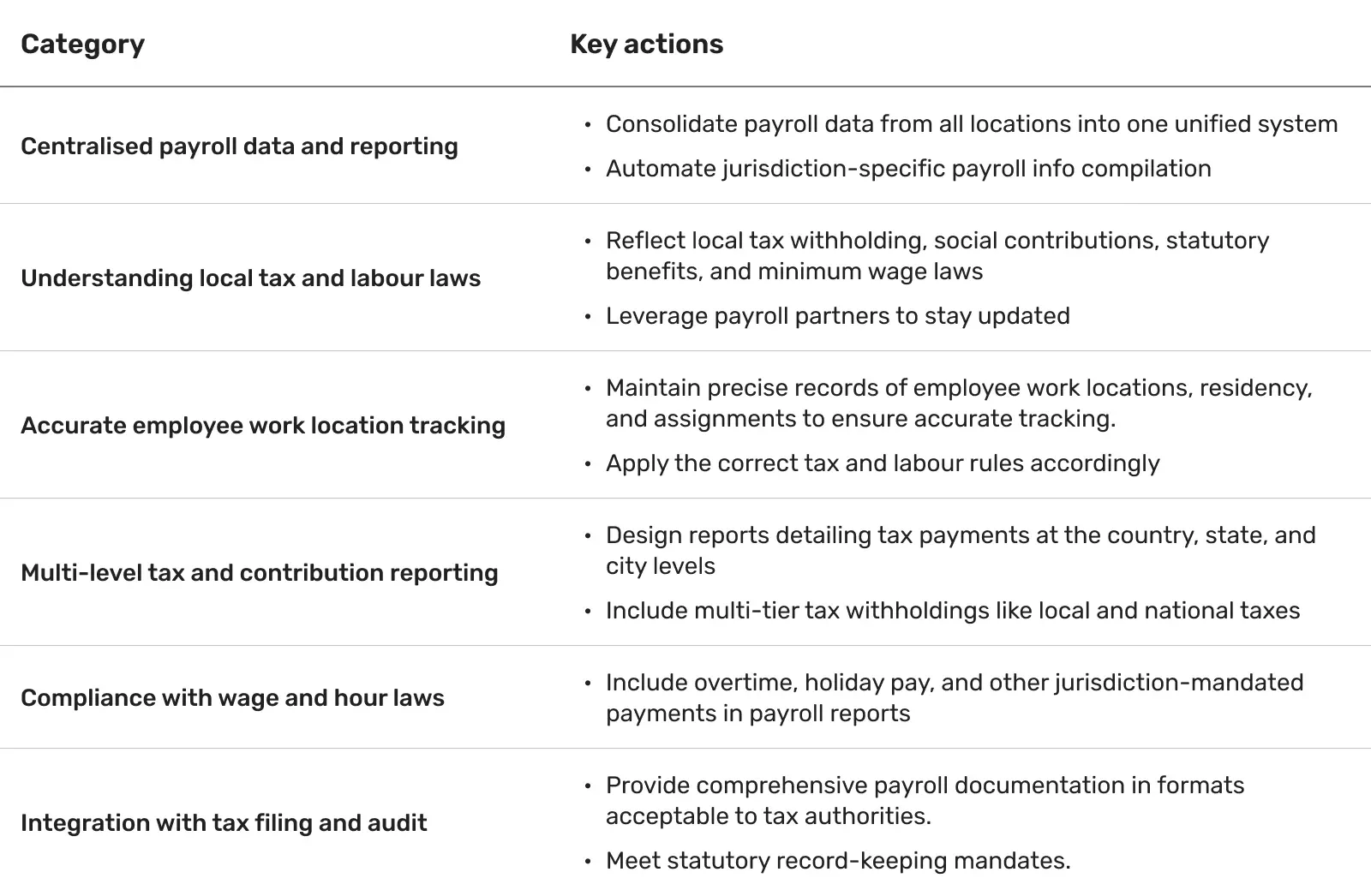
Even a quick glance at the table above shows the numerous aspects you must consider for efficient and accurate payroll.
That’s why opting for global payroll platforms is a great option.
- These AI-powered cloud payroll platforms automate compliance updates, tax calculations, and multi-currency payments, reducing human error.
- By unifying payroll, HR, and finance ecosystems, they enable seamless data flow, real-time reporting, and centralised management of global payroll expenses.
- At the same time, automation protects employee trust through timely, accurate payments and transparent payroll processes.
Regardless of how you manage payroll, ensure transparent employee communication and provide employees with detailed payslips that show tax withholdings and benefits.
Additionally, think of using multilingual portals whenever possible for global workforces.
How can Native Teams help manage global payroll?
Native Teams’ global payroll solution takes the hassle out of managing international payroll. With our tools, you can ensure your team is paid accurately and on time, with all required contributions and benefits automatically included.
Managing your global workforce is simple: you can send payroll invites, adjust salaries, and track everything from a single, centralised dashboard.
Other handy tools from our payroll suite include:
- A multi-currency wallet that allows instant fund transfers between wallets holding different currencies. Thus, you can easily charge your wallet using credit or debit cards. With our wallet, each transaction comes with a detailed receipt, providing transparency and a record of your spending.
- Global Payroll Calculator: Simplifies calculating salaries and understanding related costs across more than 85 countries. Once you select a country and employment status, and enter your salary details, you’ll instantly receive a detailed breakdown of your net and gross salaries. Also, you’ll get insights into social security contributions, tax obligations, and other deductions specific to the selected country.
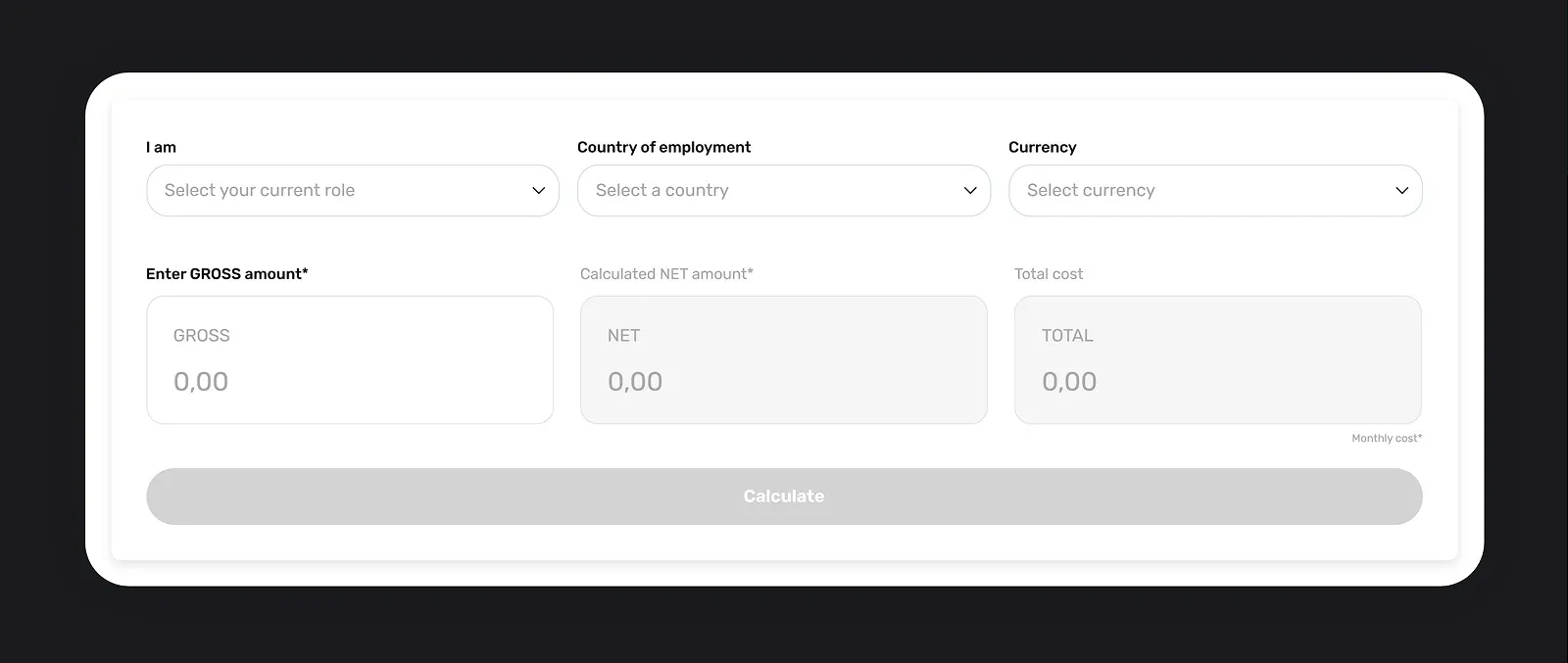
- Currency Exchange: Allows you to see the exchange rate we use for your payroll and wallet transfers. We use real-time middle exchange conversion rates, eliminating any guesswork.
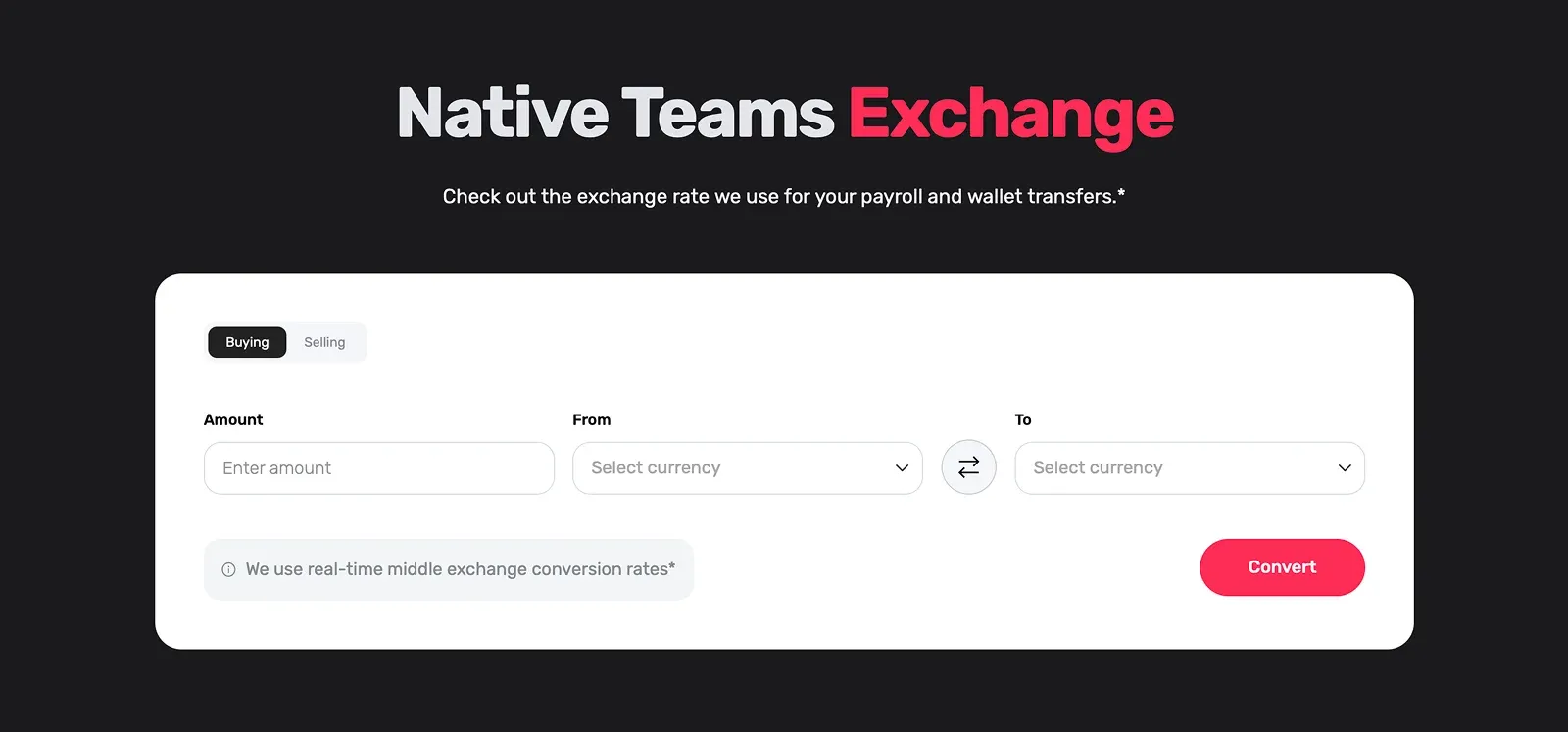
The future of hybrid work: What to aim for?
To apply a hybrid work model, you must move away from one-size-fits-all hybrid rules and toward team or function-specific approaches.
This way, you can account for varying work patterns, collaboration needs, and regulatory requirements across different teams.
A common strategy is the use of ‘anchor days’ or anchor weeks, when specific teams come together onsite for planned in-person collaboration.
These sessions are ideal for brainstorming, team-building, and alignment, while routine, individual-focused tasks can still be completed remotely.
As a result, you can preserve flexibility without sacrificing the benefits of face-to-face interaction.
Modern hybrid policies also prioritise work-life balance, helping employees integrate personal responsibilities while remaining productive.
Technology plays a key role in supporting this balance.
Dedicated digital platforms act as centralised hubs for onboarding, internal communications, learning resources, and benefits information, accessible anytime and anywhere.
Additionally, social engagement through digital channels and periodic in-person events reinforces culture, reduces isolation, and strengthens team cohesion.
EORs and global payroll platforms further help by handling tricky and complex onboarding, taxes, payroll, compliance, relocation, and employee benefits.
The future of hybrid work combines tailored policies that respect team needs and regulations with advanced, inclusive technologies.
As a result, you can enjoy enhanced engagement, productivity, and well-being in a flexible work environment.
🎁 Bonus: The future of hybrid work: The complete checklist for managing global teams
Before we wrap up, here’s a clear checklist of key focus areas and actionable strategies.
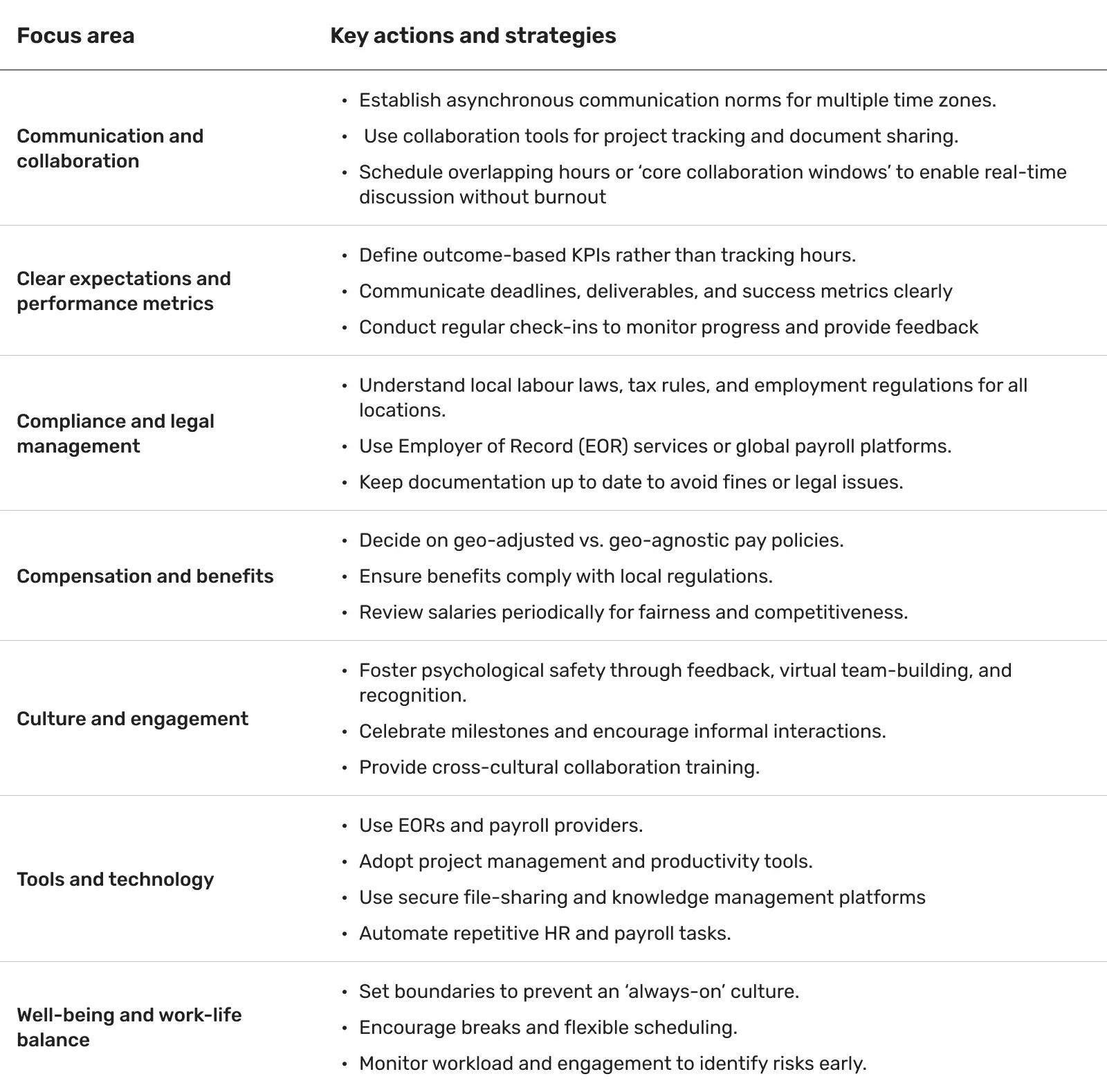
How to manage a global workforce efficiently with Native Teams?
Native Teams manages global hiring compliance by acting as the official legal employer in each country, while your company continues to oversee employees’ daily work and operations.
Here’s how we can support you:
✨ We manage contracts, payroll, tax filings, benefits, termination rules, and ensure employment practices conform to each country’s specific regulations.
✨ We handle timely salary payments, tax withholding, social contributions, and mandatory filings across jurisdictions, reducing errors and ensuring local tax compliance.
✨ We help you relocate your workforce and assist with visas and authorisations under local laws, minimising risks of fines and hiring bans.
✨ Our solution eliminates misclassification risks associated with contractors versus employees.
✨ We enable you to hire and onboard employees in new countries within days rather than months.
✨ Your employees can receive benefits such as health insurance, retirement contributions, and paid leave tailored to their location, enhancing employee satisfaction and retention.
Book a free demo today to see how Native Teams can help you build and manage your global hybrid team effortlessly.
Keep learning:
EOR vs Payrolling: What's the Difference in 2026? [Full Guide]
How to Build Relationships Working Remotely
Managing Global Payroll: A Comprehensive Guide for Remote Teams
